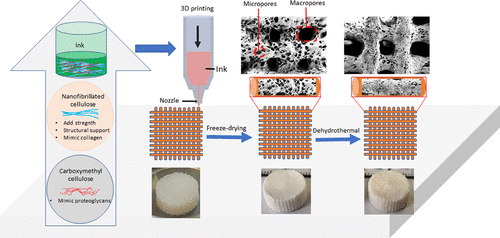当前位置:
X-MOL 学术
›
ACS Appl. Bio Mater.
›
论文详情
Our official English website, www.x-mol.net, welcomes your
feedback! (Note: you will need to create a separate account there.)
Generic Method for Designing Self-Standing and Dual Porous 3D Bioscaffolds from Cellulosic Nanomaterials for Tissue Engineering Applications
ACS Applied Bio Materials ( IF 4.6 ) Pub Date : 2020-01-28 , DOI: 10.1021/acsabm.9b01099 Tamilselvan Mohan 1 , Andreja Dobaj Štiglic 1 , Marco Beaumont 2 , Johannes Konnerth 3 , Fazilet Gürer 1 , Damjan Makuc 4 , Uroš Maver 5 , Lidija Gradišnik 5 , Janez Plavec 4 , Rupert Kargl 1, 6, 7 , Karin Stana Kleinschek 7, 8
ACS Applied Bio Materials ( IF 4.6 ) Pub Date : 2020-01-28 , DOI: 10.1021/acsabm.9b01099 Tamilselvan Mohan 1 , Andreja Dobaj Štiglic 1 , Marco Beaumont 2 , Johannes Konnerth 3 , Fazilet Gürer 1 , Damjan Makuc 4 , Uroš Maver 5 , Lidija Gradišnik 5 , Janez Plavec 4 , Rupert Kargl 1, 6, 7 , Karin Stana Kleinschek 7, 8
Affiliation

|
Three-dimensional scaffolds (3D) with controlled shape, dual porosity and long-term mechanical and dimensional stability in biofluids are of interest as biotemplates in tissue engineering. Herein, self-standing and lightweight cellulose-based biogenic scaffolds with a spatially structured morphology, macropores and interconnected micropores were fabricated using a combination of direct ink writing 3D printing and freeze-drying techniques. This was achieved by developing a water-based and low-cost bicomponent ink based on commercially available nanofibrillated cellulose (NFC) and carboxymethyl cellulose (CMC). Physical cross-linking through dehydrothermal treatment significantly increased the surface hardness, indentation modulus, compression strength, as well as the dimensional stability of the scaffolds in biofluids, in comparison to untreated materials. However, no differences in the spectra of solid state nuclear magnetic resonance or infrared were observed for dehydrothermal treated samples, suggesting that the increase of mechanical properties and dimensional stability is based on the physical cross-linking of functional groups both at the interface between NFC and CMC. The supramolecular structure of the polymers was well-preserved as disclosed by X-ray diffraction measurements. The cross-linked scaffolds showed high proliferation, viability, and attachment of human bone tissue derived osteoblast cells (hFOB). The simple and straightforward avenue proposed here for the design of cellulose-based fibrous inks and dual porous scaffolds from the commercially available materials and without the need of any additional cross-linkers should pave the way for the development of implantable, degradable scaffolds and cell-laden biomaterials for bone tissue regeneration and 3D bioprinting applications.
中文翻译:

用于组织工程应用的纤维素纳米材料设计自立式和双孔 3D 生物支架的通用方法
在生物流体中具有可控形状、双孔隙率和长期机械和尺寸稳定性的三维支架 (3D) 作为组织工程中的生物模板是令人感兴趣的。在此,使用直接墨水书写 3D 打印和冷冻干燥技术相结合,制造了具有空间结构形态、大孔和互连微孔的自立式轻质纤维素基生物支架。这是通过开发一种基于市售纳米原纤化纤维素 (NFC) 和羧甲基纤维素 (CMC) 的水性低成本双组分墨水来实现的。通过脱水热处理进行的物理交联显着提高了支架在生物流体中的表面硬度、压痕模量、抗压强度以及尺寸稳定性,与未经处理的材料相比。然而,对于脱水热处理的样品,在固态核磁共振或红外光谱中没有观察到差异,这表明机械性能和尺寸稳定性的提高是基于 NFC 和 NFC 之间界面处官能团的物理交联。中央军委。如 X 射线衍射测量所揭示的,聚合物的超分子结构保存完好。交联支架显示出高增殖、活力和人骨组织衍生成骨细胞 (hFOB) 的附着。
更新日期:2020-01-29
中文翻译:

用于组织工程应用的纤维素纳米材料设计自立式和双孔 3D 生物支架的通用方法
在生物流体中具有可控形状、双孔隙率和长期机械和尺寸稳定性的三维支架 (3D) 作为组织工程中的生物模板是令人感兴趣的。在此,使用直接墨水书写 3D 打印和冷冻干燥技术相结合,制造了具有空间结构形态、大孔和互连微孔的自立式轻质纤维素基生物支架。这是通过开发一种基于市售纳米原纤化纤维素 (NFC) 和羧甲基纤维素 (CMC) 的水性低成本双组分墨水来实现的。通过脱水热处理进行的物理交联显着提高了支架在生物流体中的表面硬度、压痕模量、抗压强度以及尺寸稳定性,与未经处理的材料相比。然而,对于脱水热处理的样品,在固态核磁共振或红外光谱中没有观察到差异,这表明机械性能和尺寸稳定性的提高是基于 NFC 和 NFC 之间界面处官能团的物理交联。中央军委。如 X 射线衍射测量所揭示的,聚合物的超分子结构保存完好。交联支架显示出高增殖、活力和人骨组织衍生成骨细胞 (hFOB) 的附着。











































 京公网安备 11010802027423号
京公网安备 11010802027423号